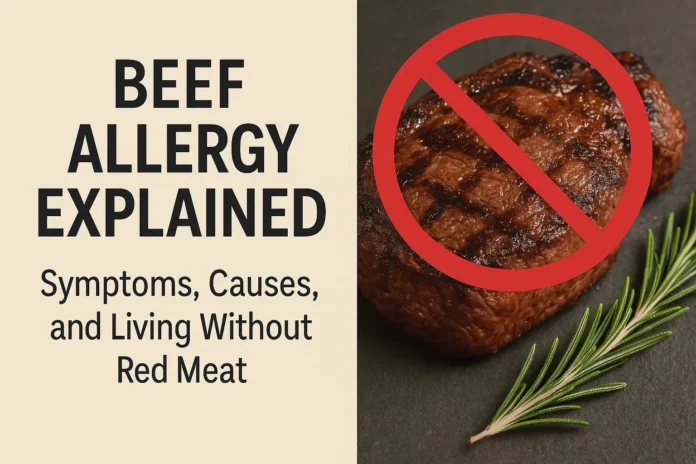Unraveling the Mystery of Beef Allergies
When you think of food allergies, common culprits like peanuts, dairy, and shellfish often come to mind. But what about beef? For many, the idea of a beef allergy seems unusual, even counterintuitive. After all, it’s a staple in diets worldwide. Yet, for a growing number of individuals, beef can trigger a range of uncomfortable and even dangerous reactions. Welcome to the often-misunderstood world of beef allergies.
Unlike more common allergies that typically manifest in childhood, beef allergies can be particularly perplexing because they often develop later in life. Imagine enjoying steaks and burgers for years, only to suddenly find yourself breaking out in hives, experiencing stomach cramps, or struggling to breathe after a beef-laden meal. This delayed onset is one of the many reasons beef allergies can be so challenging to diagnose.
Checkout Peanut Allergy: Understanding, Managing, and Living Safely
What exactly is happening?
At its core, a beef allergy is an immune system overreaction. Your body mistakenly identifies certain proteins in beef as harmful invaders and mounts an attack. The primary culprit is often a sugar molecule called alpha-gal (galactose-alpha-1,3-galactose). This isn’t just any sugar; it’s a sugar found in the tissues of most mammals, including cows, pigs, and lamb, but notably not in humans or other primates.
The Tick Connection: A Surprising Twist

Here’s where it gets truly fascinating, and a little bit creepy: for many, the development of an alpha-gal allergy is directly linked to a tick bite. Specifically, the bite of the lone star tick (Amblyomma americanum) in the US, and other tick species in different parts of the world, is a major trigger. When an alpha-gal-carrying tick bites a human, it injects alpha-gal into the bloodstream. This exposure can sensitize the person’s immune system, leading to the production of IgE antibodies specifically targeting alpha-gal. The next time that person eats red meat containing alpha-gal, their immune system goes into overdrive, triggering an allergic reaction.
Beyond Alpha-Gal: Other Beef Allergens
While alpha-gal is a leading cause, it’s important to note that not all beef allergies are alpha-gal related. Some individuals may be allergic to other specific proteins within the beef itself, though these are less common. These “true” protein allergies to beef might be present from childhood and don’t necessarily have the tick bite connection.
Symptoms: A Mixed Bag
The symptoms of a beef allergy, like any food allergy, can vary widely in severity and presentation. They can range from mild to life-threatening and often appear delayed – another characteristic that makes diagnosis tricky. Unlike immediate reactions to peanuts, alpha-gal reactions can occur 3-6 hours after ingesting beef, making it difficult for individuals to connect their symptoms to the food they ate much earlier.
Common symptoms include:
- Skin reactions: Hives, itching, eczema, flushing
- Gastrointestinal issues: Nausea, vomiting, diarrhea, stomach cramps
- Respiratory problems: Wheezing, shortness of breath, coughing, nasal congestion
- Cardiovascular symptoms: Drop in blood pressure, dizziness, fainting
- Anaphylaxis: A severe, life-threatening allergic reaction that can involve multiple body systems and requires immediate medical attention.
Checkout Living with Shellfish Allergy: Understanding the Risks & Staying Safe
Diagnosis and Management
If you suspect you have a beef allergy, it’s crucial to consult with an allergist. Diagnosis typically involves a detailed medical history, including any tick bite exposure, and specific blood tests that measure IgE antibodies to alpha-gal or other beef proteins. Skin prick tests can also be used.
Currently, there is no cure for beef allergies. The primary management strategy is strict avoidance of beef and other mammalian meats (pork, lamb, venison, goat, etc.) that contain alpha-gal. This can be incredibly challenging, as alpha-gal can also be found in unexpected places like gelatin, some medications, and even certain vaccines. Always read food labels carefully and communicate your allergy when dining out.
For those with alpha-gal syndrome, awareness of tick bite prevention is also key.
Living with a Beef Allergy: A New Normal
Living with a beef allergy, especially if it develops later in life, requires significant adjustments. It means re-evaluating dietary habits, learning to cook with alternative protein sources, and becoming a vigilant label reader. It also highlights the fascinating and sometimes bizarre ways our bodies interact with the environment.
The mystery of beef allergies is slowly being unraveled, thanks to ongoing research into alpha-gal syndrome and other less common beef protein allergies. While it may not be as widely recognized as other food allergies, its impact on those affected is profound. If you or someone you know experiences unusual symptoms after eating beef, remember that a beef allergy, though unique, is a very real possibility. Seek medical advice and take the first step towards understanding this intriguing and often-hidden food sensitivity.


